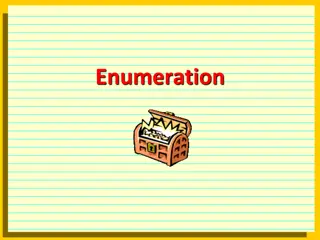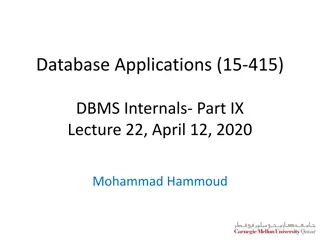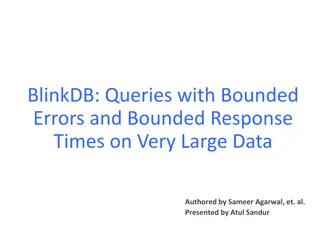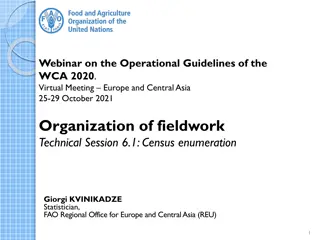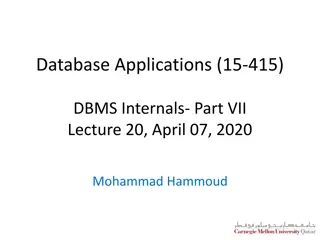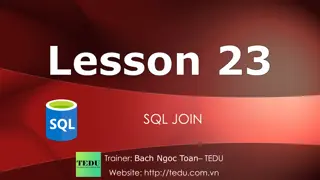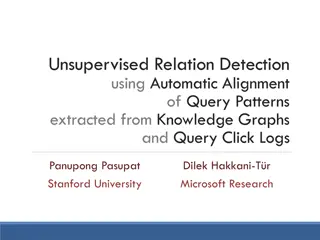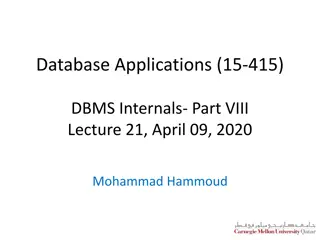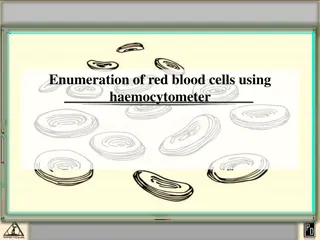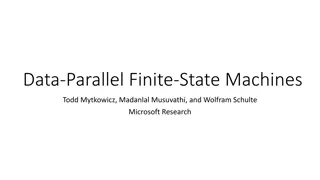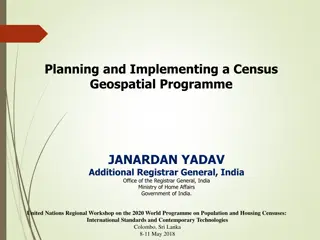Optimizing Join Enumeration in Transformation-based Query Optimizers
Query optimization plays a crucial role in improving database performance. This paper discusses techniques for optimizing join enumeration in transformation-based query optimizers, focusing on avoiding cross-products in join orders. It explores efficient algorithms for generating cross-product-free join spaces and introduces the use of graph partitioning to find the best join tree structure. The Volcano/Cascades framework and Cross-Product Suppression rulesets are also discussed as methods to enhance query optimization efficiency.
- Query Optimization
- Join Enumeration
- Transformation-based Optimizers
- Cross-Product Avoidance
- Database Performance
Download Presentation

Please find below an Image/Link to download the presentation.
The content on the website is provided AS IS for your information and personal use only. It may not be sold, licensed, or shared on other websites without obtaining consent from the author. Download presentation by click this link. If you encounter any issues during the download, it is possible that the publisher has removed the file from their server.
E N D
Presentation Transcript
Optimizing Join Enumeration in Transformation-based Query Optimizers ANIL SHANBHAG, S. SUDARSHAN IIT BOMBAY anils@mit.edu, sudarsha@cse.iitb.ac.in VLDB 2014
Query Optimization: Quick Background System R algorithm Dynamic programming algorithm to find best join order Time complexity: O(3n) for bushy join orders Plan space considered includes cross products For some common join topologies #cross-product free intermediate join results is polynomial E.g. chain, cycle, .. Can we reduce optimization time by avoiding cross products? Algorithms for generation of cross-product free join space Bottom up: DPccp (Moerkotte and Newmann [VLDB06]) Top-down: TDMinCutBranch (Fender et al. [ICDE11]), TDMinCutConservative (Fender et al. [ICDE12]) Time complexity is polynomial if #cross-product free intermediate join results is polynomial in size 2 IIT BOMBAY
Cross-Product-Free Join Order Enumeration using Graph Partitioning Key idea for avoiding cross products while finding best join tree: For set S of relations, find all ways to partition S into S1 and S2 s.t. the join graph of S1 is connected, and so is the join graph of S2 there is an edge (join predicate) between S1 and S2 S S2 S1 R1 R2 R4 R3 Simple recursive algorithm to find best plan in cross-product free join space using partitioning as above Efficient algorithms for finding all ways to partition S into S1 and S2 as above MinCutLazy (Dehaan and Tompa [SIGMOD07]) Fender et. al proposed MinCutBranch [ICDE11] and MinCutConservative [ICDE12] MinCutConservative is the most efficient currently. 3 IIT BOMBAY
Volcano/Cascades Framework for Query Optimization Based on equivalence rules: e.g. A B B A Key benefit: easy to add rules to deal with new operators e.g. outerjoin group-by/aggregate, limit, ... Memoization technique which generalizes System R style dynamic programming applicable even with equivalence rules Used in SQL Server, Tandem, and Greenplum, and several other databases, increasing adoption Transformation rule sets for join order optimization: RS-B1Commutativity + Takes O(4^n) time RS-B2Pellenkoft et. al new ruleset: O(3^n) time Left Associativity: [VLDB97] suggest Both the rulesets generate join orders with cross-products. Key contribution of paper: Efficient rulesets that avoid cross-products 4 IIT BOMBAY
with Cross-Product Suppression (CPS) Rulesets RS-B1-CPS/RS-B2-CPS: modification of RS-B1/RS-B2 to suppress cross- products, i.e. block transformation if the result has cross-product RS-B1-CPS and RS-B2-CPS have been used in some implementations but not obvious if they are complete, i.e. generate the entire search space 5 IIT BOMBAY
RS-B1-CPS Proof of Completeness Theorem: RS-B1-CPS is complete i.e. any cross-product free tree Q1 can be converted to any other cross-product free tree Q2 using RS-B1-CPS Intuition for the proof Step 1: Given any arbitrary cross-product-free tree Q1 we can convert it into a canonical cross-product free left-deep tree Qc= (..((R1 R2) R3)..) Rk) with relations in sorted order using RS-B1-CPS Step 2: Above steps can be reversed using RS-B1-CPS for any cross- product free tree Can go from any Q1 to any Q2 as above via Qc 6 IIT BOMBAY
RS-B2-CPS is Incomplete Some cross-product free trees may not be reachable from other cross- product free trees using RS-B2-CPS. Proof of incompleteness of RS-B2-CPS using counter-example below Q and Q2 are both cross-product free join trees Starting with Q, we can go to Q2 only via application of exchange rule at root join op This will always result in an intermediate tree with cross-product ! 7 IIT BOMBAY
Problem and Potential Fix Problem: RS-B1-CPS and RS-B2 are complete, however RS-B1-CPS generates exponential number of duplicates (Pellenkoft et al.) RS-B2 explores significantly larger search space (no CPS) Key idea: incorporate graph-partitioning based top-down enumeration into Volcano/Cascades framework 8 IIT BOMBAY
AND-OR DAG Representation in Volcano/Cascades Repeatedly apply a set of rules until fixedpoint Store the alternatives efficiently using AND-OR DAG representation . Example shows join enumeration for a simple query in transformation-based QO : 9 IIT BOMBAY
Join Sets For applying graph-partitioning based enumeration, we need to create a join graph consisting of nodes being joined A maximal join set at an equivalence node E is a maximal set of equivalence nodes Ei being joined below E such that none of the Ei have any join operators below them. There can be multiple maximal join sets at an equivalence node we store all of them. In the example to the right, at E0 (R1, E3 , R3) is a maximal join set, But (E1, R3) is not since E1 has join operator below it 10 IIT BOMBAY
Transformation Rule RS-Graph E Rule RS-Graph: matches pattern E1 E2 On match, For each pair (J1, J2) where J1 join sets of E1 and J2 join sets of E2 If J1 U J2 has not been enumerated at node E, where E is the parent equivalence node of E1 E2 Call the partitioning algorithm on the join graph of J1 U J2 to generate all cross-product free partitions For each such partition S1, (J1 U J2)\S1 We check if there is equivalence node representing S1 (similarly G\S1) This is done efficiently by inserting a dummy n-ary join operator into the DAG and using standard Volcano/Cascades duplicate expression check . If yes, we simply use the equivalence node in place of S1. If not, we create a left-deep join tree of relations in S1 and insert it into the DAG. Use the equivalence node thus created for S1. E2 E1 11 IIT BOMBAY
RS-Graph (Contd.) The Volcano/Cascades framework will recursively apply RS-Graph on generated nodes to generate entire space Join sets at a node may change as transformations are applied at child equivalence nodes Join sets can be maintained in a bottom-up fashion. Theorem: RS-Graph is complete Potential risk: equivalence nodes may have many maximal join sets Good news: For commonly encountered rulesets, each equivalence node has a single maximal join set. 12 IIT BOMBAY
Performance Incompleteness of RS-B2-CPS observed in cycle queries (# Eq. Nodes) LQ DAG Expansion time (ms) Chain Queries Cycle Queries Colour code in graph: RS-B2, RS-B1-CPS, RS-B2-CPS, RS-Graph RS-Graph significantly outperforms RS-B1-CPS, RS-B2, and even RS-B2-CPS (which is incomplete). (Results on RS-B2-CPS not in paper, added subsequently) 13 IIT BOMBAY
Performance LQ DAG Expansion time (ms) For star and clique join graphs Star Queries Clique Queries Colour code in graph: RS-B2, RS-B1-CPS, RS-B2-CPS, RS-Graph Further results with number of equivalence nodes, number of operation nodes, number of operation node addition attempts are in paper 14 IIT BOMBAY
Conclusion Cross-Product Free Join Order Enumeration in Transformation- based QO is inefficient : RS-B1-CPS is complete but generates exponential number of duplicates RS-B2-CPS is incomplete RS-B2 explores a significantly larger space We propose a new ruleset RS-Graph which uses join graph partitioning It is complete It does not generate duplicates Performs significantly better than existing rulesets 15 IIT BOMBAY
Thank You IIT BOMBAY
RS-Graph is Complete Proof consists of two parts: An equivalence node stores all the maximal join sets Having all the join sets, the RS-Graph rule generates all the join order alternatives below the equivalence node Part 2 was shown by Pit Fender et. al, given a join set we construct the join graph. The partitioning algorithm generates all S1 S2 alternatives possible below this equivalence node. Part 1 comes from the correctness of the join set maintenance. Interested reader may refer to the paper for this. 17 IIT BOMBAY
Potential Risk Each equivalence node stores a set of maximal join sets. There may be multiple maximal join sets and hence we might have blow up ? Good news: For commonly encountered rulesets, this does not happen. Each equivalence node has a single maximal join set. Consider the example to the right: The set of maximal join sets of E0consists of single entry [({R1E3R3}, {t2t0})] 18 IIT BOMBAY


